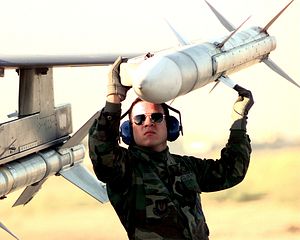Speaking to sailors aboard the aircraft carrier USS Carl Vinson at the end of September, Secretary of Defense Ashton Carter provided a clear and succinct explanation of what the Defense Department has done during the Obama administration’s “Pivot” to Asia. He also placed the Defense Department’s efforts in Asia in the context of his broader initiative, the “third offset,” which seeks to leverage new technologies and concepts to preserve the United States’ decisive military advantages. Various critics complain the pivot (later rebranded as the “Rebalance”) was as a failure, under-resourced, or an empty promise. Simply comparing numbers of U.S. and Chinese ships and aircraft might give credence to the idea of a hollow effort, which is why it is important to understand the role of emerging “third offset” capabilities and operational concepts for the military component of the rebalance to deter regional aggression.
To some extent, critics grade the rebalance against their own criteria, rather than those the Obama administration set for itself, and do not consider the rebalance as part of a longer government effort that will probably continue into the next administration and beyond. The opening of Myanmar, cooperation against the North Korean nuclear program, and implementation of the Paris Climate accords are all substantive diplomatic achievements of Obama’s two-term presidency. Militarily, China may trouble its South China Sea neighbors — and it remains uncertain whether the Chinese will comply with this summer’s Hague ruling against the basis for Chinese claims and activity in the Philippines’ Exclusive Economic Zone. But so far the disputes have not flashed into conflict and the “third offset” is designed to ensure that they don’t.
The DoD’s Rebalance
Secretary Carter broke the Defense Department’s rebalance efforts into three phases. In the first phase, the U.S. military began realigning forces so that 60 percent of U.S. naval and air power is based in the Pacific by 2020, and redistributed those forces geographically to create new centers of gravity in places like Guam, Australia, and Singapore. In the second phase, it began qualitatively improving the capabilities of forces already in the Pacific, and renewed a push to forge new or stronger regional military relationships with countries like Vietnam, Indonesia, and India. Entering the third phase, the U.S. seeks to integrate those regional partners into a stronger and more cooperative security network, while making significant improvements to U.S. military capabilities in the region.
Without using the term, the capability upgrades that Secretary Carter describes for the third phase of the U.S. rebalance fit squarely within the Defense Department’s “third offset.” Those capabilities include tripling the cruise missile capacity of the Virginia-class attack submarines, investing in unmanned undersea drones, long-term air superiority investments and long range bomber capability, new buys of the F-35 strike fighter, upgrading the Air Force’s fleet of in-flight refueling tankers, modifying the SM-6 anti-air missile to also have a long-range anti-ship capability, and new precision munitions and cruise missile concepts.
The Third Offset in Asia
In March, Undersecretary of Defense Robert Work sat for a discussion with David Ignatius of the Washington Post that provides important context for understanding where these investments fit within the “third offset.” He explained that the three goals of the offset are to, “achieve comprehensive stability, reduce any incentive for preemption, and if we do come to blows, end it quickly before we trip over a nuclear threshold.” He defined comprehensive stability as comprising three complementary pillars of deterrence against conflict: strategic (that is, nuclear), conventional, and economic. The “third offset” seeks to ensure the conventional deterrent pillar is effective.
Undersecretary Work explained further that part of the offset strategy was to “reveal for deterrence” but “conceal for warfighting advantage.” Secretary Carter’s listing of forthcoming force structure investments in the Pacific is part of the “reveal” component. By advertising some capabilities to potential adversaries, the hope is to convince them that they could not achieve victory over U.S. forces, at least not at an acceptable cost. But the strategy also recognizes that deterrence may fail. If a conflict does break out, the objective is to ensure that the U.S. can “end it quickly” with the aid of key capabilities and concepts that are kept secret, the “conceal for warfighting advantage” component.
Secretary Carter alluded to such concealed capabilities when describing improvements to cruise missiles and anti-ship missiles, and then “some very creative – and we’re sure unexpected by potential foes – ways to use such missiles across the varied domains of the Asia-Pacific.” This echoes remarks Admiral John Richardson, the Chief of Naval Operations, made to the Center for American Progress in September that “we have a number of answers” to operating within an anti-access/area denial environment in Asia, and that the Navy was working on “creative things to do” offensively once within it.
However, some “third offset” initiatives have had ambiguous, possibly even de-stabilizing effects. Undersecretary Work described fallout from the Conventional Prompt Global Strike program, a hypersonic system still in testing that promised to be able to hit any target on earth within one hour without resorting to a nuclear missile. The Defense Department expected that disclosing this technology would enhance conventional deterrence, but instead Russia perceived it as threatening a decapitating first strike. Both Russia and China are now believed to be pursuing global hypersonic systems of their own. In this case, a conventional “third offset” system may undermine both the strategic deterrence pillar of comprehensive stability and the intent to reduce incentives for preemption by others.
“We’re going to have a few more surprises as well,” Secretary Carter told the Vinson crew, “These ‘leap-ahead’ investments will keep us ahead in the Asia-Pacific.” Both the advertised and these secret capabilities suggest that there is more to the Defense Department’s Asia rebalance and its integration with the “third offset” than some critics credit it. It is also clear that there can be unintended consequences to the mix of “revealed” and “concealed” capabilities they deploy in Asia.

































